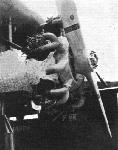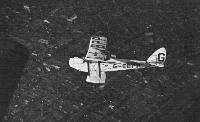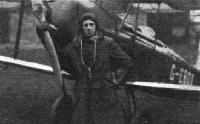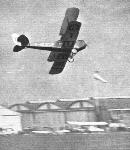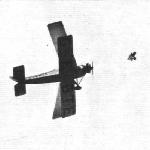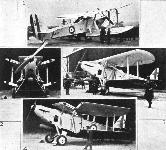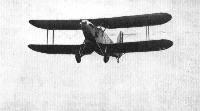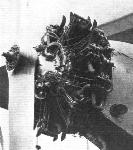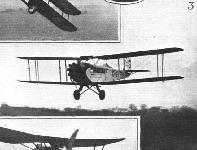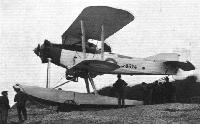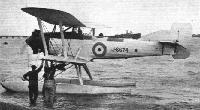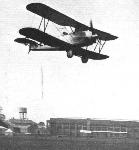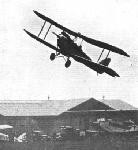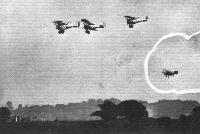Фотографии
-
A NEW PARACHUTE: The rapid opening after Mr. John Tranum left the D.H.9 at 1,000 ft. with the Russell "Lobe" Parachute
Самолёты на фотографии: De Havilland D.H.9 - Великобритания - 1917
-
PARACHUTE DISPLAY AT STAG LANE AERODROME: Mr. John Tranum, an exhibition jumper, with the American parachute known as the Russell "Lobe" Parachute, with which he made three descents at Stag Lane on May 10. The machine is the D.H.9 from which the demonstration was given.
Самолёты на фотографии: De Havilland D.H.9 - Великобритания - 1917
-
The Gnome-Rhone Bristol "Titan," as used on the Fokker F.VII chartered by Mr. Van Lear Black for a flight to the Cape and back, is built up very largely from "Jupiter" parts. Five "Jupiter" cylinders are used, and the French version of the engine is rated at 240 h.p. The Bristol "Titan" has not yet gone into production, as the Bristol company desires to be quite sure what type of engine is likely to be wanted before commencing building in quantities. The Gnome-Rhone company, on the other hand, has gone into production with the "Titan."
Самолёты на фотографии: Fokker F.VII / C-2 / F.XIV - Нидерланды - 1924
-
Регистрационный номер: H-NADP AN AIR YACHT DE LUXE: The three-engined Fokker monoplane which Mr. Van Lear Black has chartered from the K.L.M. for his tour to the Cape and back. The pilots will be Geysendorffer and Scholte, and Mr. Black will be accompanied by his valet "Leo." The tour is scheduled to start around May 15. The engines are the new Gnome-Rhone Bristol "Titans."
Самолёты на фотографии: Fokker F.VII / C-2 / F.XIV - Нидерланды - 1924
-
Регистрационный номер: G-EBPH REPRESENTATIVE TYPES OF BRITISH AIRCRAFT: 2. The Avro-Alpha training machine.
Самолёты на фотографии: Avro Avro 504 - Великобритания - 1913
-
THE SUPERMARINE-NAPIER S-5 IN A MATCHBOX - NEARLY! A neat little car mascot of the Schneider Trophy winner, standing beside an ordinary matchbox. This mascot is being produced by Messrs. Lejeune, of 132, Great Portland Street, W.I.
Самолёты на фотографии: Supermarine S.5 / S.6 - Великобритания - 1927
-
D.H.50A's CARRY DISTINGUISHED AUSTRALIAN PASSENGERS: On the left, His Excellency Lord Stonehaven and Capt. Davidson, prior to leaving on their flight to Tatura in the "Wattle Bird." On the right, the Prime Minister and Mrs. Bruce emplaning in the "Lyre Bird," for a flight to Adelaide.
Самолёты на фотографии: De Havilland D.H.50 - Великобритания - 1923
-
DE HAVILLANDS IN AUSTRALIA: A "Nimbus"-engined D.H.50A, assembled by De Havilland Aircraft Pty., Melbourne.
Самолёты на фотографии: De Havilland D.H.50 - Великобритания - 1923
-
Регистрационный номер: G-EBPP Flying over Sydney: This photograph shows Maj. H. de Havilland, D.S.O., flying a "Cirrus-Moth" during his visit last year.
Самолёты на фотографии: De Havilland Moth / D.H.60 - Великобритания - 1925
-
Регистрационный номер: G-EBOO, G-EBOU WAKEFIELD HANDICAP: Flt.-Lieut. Le Poer Trench on the Halton monoplane "OO," leading Flt.-Lieut Soden on his D.H. "Moth" (Genet) "OU" in the second lap of the race, which was eventually won by the former at 80 1/2 m.p.h.
Самолёты на фотографии: De Havilland Moth / D.H.60 - Великобритания - 1925Halton H.A.C.1 Mayfly/H.A.C.2 Minus - Великобритания - 1927
-
NEW CLUB INSTRUCTOR: When the Norfolk and Norwich Aero Club's pilot instructor, Capt. Lines, left them some time ago to join an aviation company, Mr. F. Fry, photographed above, beside a D.H."Moth" at the Mousehold aerodrome, was chosen to fill the vacancy. He is an excellent instructor and has been a Sergeant Pilot in the R.A.F.
Самолёты на фотографии: De Havilland Moth / D.H.60 - Великобритания - 1925
-
Members of the Sydney Club standing in front of a de Havilland "Cirrus-Moth."
Самолёты на фотографии: De Havilland Moth / D.H.60 - Великобритания - 1925
-
Регистрационный номер: G-NZAT A DE HAVILLAND "CIRRUS-MOTH" IN NEW SURROUNDINGS: A typical sheep run in New Zealand.
Самолёты на фотографии: De Havilland Moth / D.H.60 - Великобритания - 1925
-
Регистрационный номер: G-EBRY A NEW PARACHUTE: The D.H. "Moth" was, as usual, ready to assist by providing a "wind" to open the parachute on the ground. In the group are Air Ministry representatives and other experts. Behind the cords and hatless is Mr. C. A. Pike, who piloted the D.H.9 for the occasion. Miss June, the well-known parachutist, is on the left facing the camera.
Самолёты на фотографии: De Havilland Moth / D.H.60 - Великобритания - 1925
-
Регистрационный номер: G-EBMF Flying in a Thunderstorm: Mr. S. F. Mathews during the Talbot O'Farrell Race, flying "Moth" MF, an old-timer with Mark I "Cirrus" engine.
Самолёты на фотографии: De Havilland Moth / D.H.60 - Великобритания - 1925
-
Регистрационный номер: G-EBRO [2], G-EBSN, G-EBVU THE BRISTOL AIR PAGEANT: A portion of the "Parade." Nearest the camera is a de Havilland "Cirrus-Moth." Ahead of that a Westland "Cirrus-Widgeon," an Avro "Cirrus-Avian" and a Blackburn "Genet-Bluebird."
Самолёты на фотографии: Avro Avian / Type 594/616 - Великобритания - 1926Blackburn Bluebird / L.1 - Великобритания - 1924De Havilland Moth / D.H.60 - Великобритания - 1925Westland Widgeon - Великобритания - 1924
-
Регистрационный номер: G-AUFV DE HAVILLANDS IN AUSTRALIA: An Australian-built "Cirrus-Moth."
Самолёты на фотографии: De Havilland Moth / D.H.60 - Великобритания - 1925
-
Регистрационный номер: G-EBLW, G-EBSZ AT HAMBLE: Mr. Lowdell on the Blackburn "Bluebird" "SZ" is seen leading Flt.-Lieut. Rose on the D.H. "Moth" "LW".
Самолёты на фотографии: Blackburn Bluebird / L.1 - Великобритания - 1924De Havilland Moth / D.H.60 - Великобритания - 1925
-
AT THE DETROIT SHOW: The Bellanca Monoplane with Whirlwind Engine.
Самолёты на фотографии: Bellanca Pacemaker / Skyrocket - США - 1928
-
Регистрационный номер: G-EBND The fast single-seater Avro "Avenger," which tore along the enclosures and then zoomed, piloted by Flt.-Lieut. Luxmoore.
Самолёты на фотографии: Avro Avenger / Type 566 - Великобритания - 1926
-
Регистрационный номер: G-EBTE [3] TWO "IMPS": On the right is Mr. Bolas, designer of the Parnall "Imp" which won the Balloon Bursting Competition. With him is Flt.-Lieut. Bonham Carter, who flew it.
Самолёты на фотографии: Parnall Imp - Великобритания - 1927
-
Регистрационный номер: G-EBTE [3] This is a general view of the machines grouped round the enclosures with the Parnall "Imp" in the foreground.
Самолёты на фотографии: Parnall Imp - Великобритания - 1927
-
Регистрационный номер: G-EBTE [3] Balloon "Strafing": Flight-Lieut. Bonham Carter well on his target in the Parnall "Genet-Imp." The swept-back top plane of this machine caused an onlooker to describe it as "An 'Autogiro' with one vane seized up."
Самолёты на фотографии: Parnall Imp - Великобритания - 1927
-
Senor de la Cierva flying his Autogiro above the crowd with a passenger in the rear cockpit. It was fitted with an Armstrong-Siddeley "Lynx," and attracted its usual delight amongst the public.
Самолёты на фотографии: Cierva/Avro C.8 / C.9 - Великобритания - 1926
-
Регистрационный номер: G-EBRO [2] THE BRISTOL AIR PAGEANT: A general view of the car park and some of the aeroplanes.
Самолёты на фотографии: Westland Widgeon - Великобритания - 1924
-
Регистрационный номер: G-EBRQ WAKEFIELD HANDICAP: The machines being wheeled between the posts at the end of the Utility Race.
Самолёты на фотографии: Westland Widgeon - Великобритания - 1924
-
Some of the distinguished visitors in front of the Blackburn "Ripon."
Самолёты на фотографии: Blackburn Ripon / T.5 - Великобритания - 1926
-
Регистрационный номер: G-EBWE SOME BLACKBURN AEROPLANES "ON PARADE": Left to right, a "Cirrus-Bluebird," a "Genet-Bluebird," a "Lynx-Lincock," a "Napier" Ripon, and a "Napier-Dart."
Самолёты на фотографии: Blackburn Bluebird / L.1 - Великобритания - 1924Blackburn Lincock / F.2 - Великобритания - 1928Blackburn Ripon / T.5 - Великобритания - 1926Blackburn Swift T.1 / Dart T.2 - Великобритания - 1920
-
Регистрационный номер: N231 [2] THE BLACKBURN "RIPON" TORPEDOPLANE: Fitted with a Napier "Lion" engine, this machine carries a 1,400 lb. torpedo, the placing of which is shown in above photographs which illustrate the machine from various viewpoints, with wings folded and spread.
Самолёты на фотографии: Blackburn Ripon / T.5 - Великобритания - 1926
-
The Blackburn "Ripon" with Napier "Lion X" engine, after taking off
Самолёты на фотографии: Blackburn Ripon / T.5 - Великобритания - 1926
-
Регистрационный номер: N231 [2] The Blackburn "Ripon" with Napier "Lion X" engine, descending to near sea level, and finally dropping the torpedo. The pilot during this demonstration was Captain A. M. Blake.
Самолёты на фотографии: Blackburn Ripon / T.5 - Великобритания - 1926
-
REPRESENTATIVE TYPES OF BRITISH AIRCRAFT: 1. The Westland "Wapiti-Jupiter" general purpose two-seater.
Самолёты на фотографии: Westland Wapiti - Великобритания - 1927
-
The only military machine at Detroit is a Vought Corsair, which is exhibited as a landplane. It is here seen in its seaplane form.
Самолёты на фотографии: Vought O2U/O3U/V-65/V-93 Corsair - США - 1926
-
Регистрационный номер: D-1167 THE GERMAN-IRISH ATLANTIC FLIGHT: The Junkers monoplane, "Bremen," on the rocky and snow-covered Greenly Island, where Baron von Huenefeld, Capt. Koehl, and Maj. Fitzmaurice landed on April 13, after their 37-hour flight across the Atlantic.
Самолёты на фотографии: Junkers W 33 / W 34 / Ju.46 - Германия - 1926
-
A "Jupiter" Engined Junkers for New Guinea. An Australian company, the New Guinea Gold Co., which is at present prospecting for gold in New Guinea, has acquired a Junkers W-34 monoplane, fitted with a Bristol ''Jupiter'' engine for the work. The mining area is situated 65 miles from the coast at an altitude of 10,000 ft. and owing to the difficult nature of the country a round trip to and from the mine area takes about three weeks by ordinary methods! The air trip takes about one hour. There is no possible landing place between the two aerodromes, so engine reliability is essential - hence the "Jupiter." (Note. - Our pictures were not taken in New Guinea!)
Самолёты на фотографии: Junkers W 33 / W 34 / Ju.46 - Германия - 1926
-
The Armstrong-Siddeley "Leopard" Aero Engine as fitted in a Hawker "Horsley" bomber.
Самолёты на фотографии: Hawker Horsley / Dantorp - Великобритания - 1925
-
AT THE DETROIT SHOW: The Fokker "Super-Universal," with Pratt and Witney "Wasp" Engine.
Самолёты на фотографии: Fokker/Atlantic F.9 Universal / F.18 / F.XI Super Universal - США - 1926
-
AT THE DETROIT SHOW: The Hamilton all-metal resembles the Junkers machines in construction and in general design.
Самолёты на фотографии: Hamilton H-45 / H-47 Metalplane - США - 1928
-
HAMPSHIRE AIR PAGEANT: The Avro "Bison" descending after being defeated by the (distant) Fairey "Flycatcher" in the aerial combat.
Самолёты на фотографии: Avro Bison / Type 555 - Великобритания - 1921Fairey Flycatcher - Великобритания - 1922
-
HOME: The Avro "Avian III" ("Cirrus" 30-80 h.p. engine) taxying in at Croydon aerodrome on May 17 after the first solo light 'plane flight from Cape Town to England. In the background are some mechanics of A.D.C. Aircraft whose engine played such a reliable part in Lady Heath's tour.
Самолёты на фотографии: Avro Avian / Type 594/616 - Великобритания - 1926
-
Sir.Charles Wakefield's Gift: The Avro "Cirrus-Avian" presented by Sir Charles to the Federal Government was handed over by Mr. Bruce to the Australian Aero Club; (N.S.W. Section) on March 31 at Mascot aerodrome. In the photograph the machine is seen just after being erected at the Larkin Works, Melbourne.
Самолёты на фотографии: Avro Avian / Type 594/616 - Великобритания - 1926
-
PENALTY OF FAME: Lady Heath was besieged by photographers at Croydon aerodrome when she landed on May 17, and is here seen facing the battery beside her reliable Avro "Avian" ("Cirrus"). A large crowd raised cheers as she stepped from the machine.
Самолёты на фотографии: Avro Avian / Type 594/616 - Великобритания - 1926
-
Регистрационный номер: G-EBVZ Taking Over: A new Avro "Avian" going through its acceptance test with Miss Winifred Brown on board, who afterwards purchased it. She is a member of the Lancashire Aeroplane Club and learned to fly as such. One of her recent flights was to Croydon from the north, on the occasion of the visit of the King of Afghanistan.
Самолёты на фотографии: Avro Avian / Type 594/616 - Великобритания - 1926
-
AT HAMBLE: The two Avro "Avians," flown by Flt.-Lieut. Luxmoore and Capt. H. A. Brown, fighting their duel in the Morris Open Handicap, with the former on "XY" leading.
Самолёты на фотографии: Avro Avian / Type 594/616 - Великобритания - 1926
-
A Private Owneress at the Bristol Meeting: Miss Winifred Brown, seated in the cockpit of her "Cirrus-Avian."
Самолёты на фотографии: Avro Avian / Type 594/616 - Великобритания - 1926
-
Регистрационный номер: G-CAJT THE DE HAVILLAND D.H.61 AS A SEAPLANE: The first of the type, christened "Canberra" was a landplane with Bristol "Jupiter VI," and was sold to a firm in Australia. Having proved very efficient in its original form, the D.H. 61 has now been produced as a seaplane, with geared "Jupiter," and is here seen undergoing trials at Rochester, piloted by Captain Hubert Broad.
Самолёты на фотографии: De Havilland Giant Moth / D.H.61 - Великобритания - 1927
-
Регистрационный номер: G-EBTL REPRESENTATIVE TYPES OF BRITISH AIRCRAFT: 3. de Havilland D.H.61 "Canberra," with Bristol "Jupiter," a commercial biplane.
Самолёты на фотографии: De Havilland Giant Moth / D.H.61 - Великобритания - 1927
-
Регистрационный номер: G-EBVO [2] The little Blackburn "Lincock" with Armstrong-Siddeley "Lynx" engine, piloted by Sqdr.-Ldr. Jack Noakes. This is a new class of machine, known as a "light fighter."
Самолёты на фотографии: Blackburn Lincock / F.2 - Великобритания - 1928
-
Регистрационный номер: G-EBVO [2] INTRODUCING A NEW CLASS IN FIGHTERS: The Blackburn "Lincock" with Armstrong-Siddeley "Lynx" engine is of a type known as a "light fighter." It was demonstrated during the visit to Brough by Squadron-Leader Jack Noakes, who did some amazing "crazy-flying" on it.
Самолёты на фотографии: Blackburn Lincock / F.2 - Великобритания - 1928
-
AT THE BRISTOL MEETING: The R.A.F. contribution was in the form of demonstrations, bombing and machine-gunning by three Hawker "Woodcocks" with Bristol "Jupiter" engines, here seen in formation "line astern."
Самолёты на фотографии: Hawker Woodcock - Великобритания - 1923
-
AIR MINISTER'S CHANNEL CRUISE: This week Sir Samuel Hoare is making a cruise of (inspection to the Channel Islands, Scilly Islands, &c, in one of the new Short all-metal "Calcutta" flying boats with "Jupiter" engines. The "Calcutta" is seen at the moment of departure, while in the foreground is the Supermarine "Southampton"-Napier which is escorting the Air Minister on his cruise.
Самолёты на фотографии: Short Calcutta / Rangoon / S.8 - Великобритания - 1928Supermarine Southampton / Solent - Великобритания - 1925
-
Регистрационный номер: J8674 [5] REPRESENTATIVE TYPES OF BRITISH AIRCRAFT: 1. The Gloster "Goring-Jupiter" two-seater seaplane.
Самолёты на фотографии: Gloster Goring - Великобритания - 1927
-
Регистрационный номер: J8674 [5] THE GLOSTER "GORING" SEAPLANE IN FLIGHT: These photographs were obtained during full-load trials over Southampton Water. The pilot was Mr. Rex Stocken.
Самолёты на фотографии: Gloster Goring - Великобритания - 1927
-
Регистрационный номер: J8674 [5] The Gloster "Goring" as a Seaplane: Side view of the machine on the beach. Note the bombs suspended under the bottom plane.
Самолёты на фотографии: Gloster Goring - Великобритания - 1927
-
Регистрационный номер: J8674 [5] Gloster G.25 Goring проектировался под спецификацию от 1925 года на торпедоносец-бомбардировщик, в серию не пошел, но активно использовался как летающая лаборатория.
The Gloster "Goring" about to go out for a flight over Southampton Water.Самолёты на фотографии: Gloster Goring - Великобритания - 1927
-
Регистрационный номер: J8674 [5] OFF FOR FULL-LOAD TRIALS: The Gloster "Goring" taxying out for a start. In this and the other photographs the machine is shown with Bristol "Jupiter VI." Actually it was designed for, and can be obtained fitted with the "Jupiter VIII" geared engine, when an even better performance, particularly in the matter of take-off and climb, is obtained.
Самолёты на фотографии: Gloster Goring - Великобритания - 1927
-
THE GLOSTER "GORING"AS A LANDPLANE: The single-bay bracing, down-curving wing roots, streamlined "nose" and general "cleanness" bear testimony to Gloster racing experience applied to service types. The engine is a Bristol "Jupiter."
Самолёты на фотографии: Gloster Goring - Великобритания - 1927
-
Регистрационный номер: X4253 At the Detroit Show: Three-quarter front view of the Wallace "Touroplane."
Самолёты на фотографии: Wallace Touroplane - США - 1928
-
At the Detroit Show: The Loening 4-passenger amphibian is engined by a Pratt and Witney Wasp.
Самолёты на фотографии: Loening Air Yacht - США - 1928
-
Under the Australian Flag: A Supermarine "Southampton" with Napier "Lion" engines recently delivered to the R.A.A.F. This machine is able to fly with one of its two engines stopped.
Самолёты на фотографии: Supermarine Southampton / Solent - Великобритания - 1925
-
SURVEYING THE GREAT BARRIER REEF: A composite photograph showing one of the Supermarine-Napier "Seagulls" alighting at Kennedy Sound.
Самолёты на фотографии: Supermarine Seal / Seagull - Великобритания - 1921
-
SURVEYING THE GREAT BARRIER REEF: Supermarine-Napier "Seagulls" were used very successfully for this work. Our photograph shows one of the "Seagulls" alighting off Bowen
Самолёты на фотографии: Supermarine Seal / Seagull - Великобритания - 1921
-
Регистрационный номер: A9-1, A9-2 Auxiliaries to "Seagulls" A9-1 and 2.
Самолёты на фотографии: Supermarine Seal / Seagull - Великобритания - 1921
-
A SEAGULL'S NEST: The three Supermarine "Seagulls" housed in their hangar at Bowen. Below, two of them are seen on the tarmac.
Самолёты на фотографии: Supermarine Seal / Seagull - Великобритания - 1921
-
SURVEYING THE GREAT BARRIER REEF: Supermarine-Napier "Seagulls" were used very successfully for this work. Our photograph shows one of the "Seagulls" taxying up the beach on its wheel undercarriage, which proved very useful at low tide.
Самолёты на фотографии: Supermarine Seal / Seagull - Великобритания - 1921
-
REPRESENTATIVE TYPES OF BRITISH AIRCRAFT: 3. The Vickers "Valiant-Jupiter" general purpose two-seater.
Самолёты на фотографии: Vickers Vixen / Venture / Valparaiso / Valiant - Великобритания - 1923
-
Winning the Talbot O'Farrell Race: Mr. Uwins crossing the finishing line on his Bristol "P.T.M." biplane with Bristol "Lucifer" engine. His average speed was 109 m.p.h.
Самолёты на фотографии: Bristol Taxiplane / Primary Trainer - Великобритания - 1923
-
AT HAMBLE: In the picture are the machines lined up for the important Morris Open Handicap, and the nearest machine is Cant. Stack's Martinsyde-Nimbus, which won it at a speed of 129 3/4 m.p.h.
Самолёты на фотографии: Martinsyde A.D.C.1 / Nimbus - Великобритания - 1924
-
Регистрационный номер: G-EBOJ REPRESENTATIVE TYPES OF BRITISH AIRCRAFT: 4. The A.D.C. "Nimbus-Martinsyde" single-seater fighter.
Самолёты на фотографии: Martinsyde A.D.C.1 / Nimbus - Великобритания - 1924
-
A RECORD BREAKER: The De Havilland "Hound'' having its Napier Series XI engine warmed up before the record flight.
Самолёты на фотографии: De Havilland Hound / D.H.65 - Великобритания - 1926
-
Capt. Broad in the cockpit.
Самолёты на фотографии: De Havilland Hound / D.H.65 - Великобритания - 1926
-
THREE WORLD'S RECORDS FOR GREAT BRITAIN: On April 27 Capt. Hubert Broad, flying a De Havilland "Hound" fitted with Napier Series XI engine, established three new world's records for speed with a useful load of 2,000 kgs. Our photograph shows the "Hound" in flight
Самолёты на фотографии: De Havilland Hound / D.H.65 - Великобритания - 1926
-
At the Detroit Show: The Eastman flying-boat, 80 h.p. Anzani, although a tractor sesquiplane, revives the open girder tail booms.
Самолёты на фотографии: Eastman E-2 Sea Rover - США - 1928
-
The Hurd Low-Wing Monoplane.
Самолёты на фотографии: Hurd monoplane - США - 1928
-
Demonstrating the "Sploth": Sqdn.-Ldr. England giving a demonstration of "How not to fly," on the de Havilland "Cirrus-Moth" with which he is shortly starting a tour of Europe.
Самолёты на фотографии: De Havilland Gipsy Moth / Moth X - Великобритания - 1928
-
HAMPSHIRE AIR PAGEANT: The four R.A.F. Gloster "Gamecocks" flying in formation during their exhibition of drill at the Pageant, flown by Sqdr.-Ldr. C. N. Lowe, Flt.-Lieut. A. C. Collier, and Flying Officers N. A. P. Pritchett and H. C. O. Hayter.
Самолёты на фотографии: Gloster Gamecock - Великобритания - 1925
Статьи
- Flight


